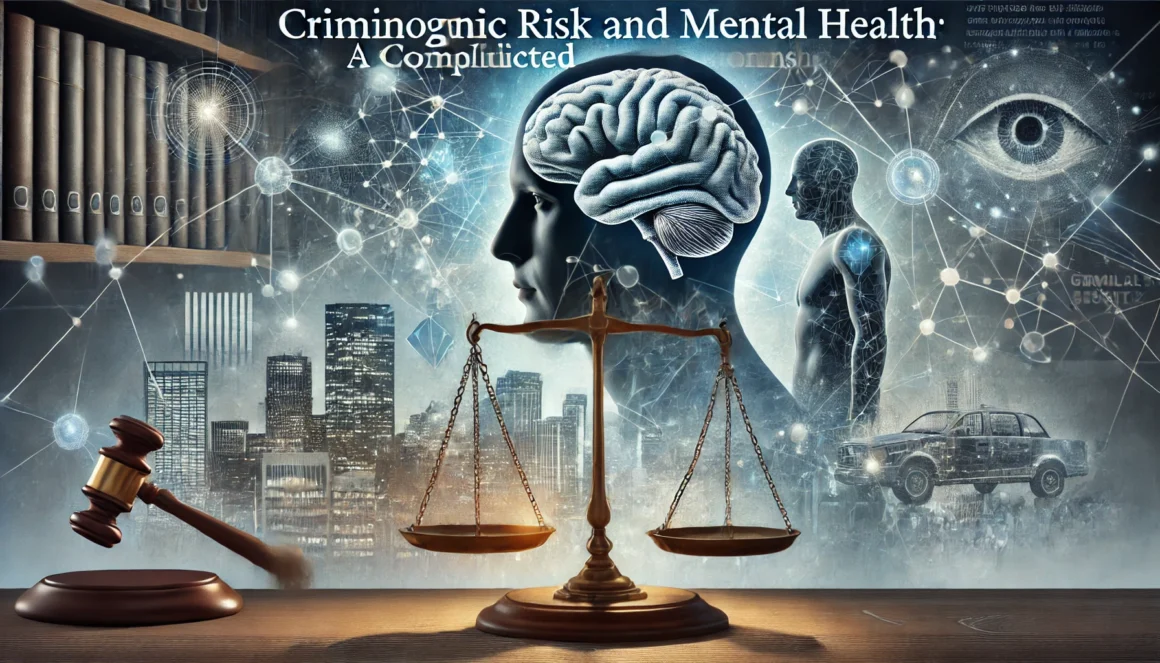Introduction
The connection between criminogenic risk and mental health is a topic of great complexity. Factors like criminal behavior predictors, emotional health, and psychological well-being play a significant role in understanding the intricate relationship between crime and mental health challenges. This article delves into the nuanced dynamics between crime risk and mental health, exploring crime-related risk factors and their impact on individuals and society.
What Is Criminogenic Risk?
Criminogenic risk refers to characteristics or factors that increase the likelihood of an individual engaging in criminal behavior. These criminological risk indicators are often used by the justice system to predict recidivism and assess the need for intervention.
Common Crime-Related Risk Factors:
- Behavioral health issues like substance abuse.
- Socioeconomic challenges, including poverty and unemployment.
- Cognitive health concerns such as impaired decision-making.
Understanding these offending risk factors is essential for addressing the root causes of criminal behavior.
Mental Health and Its Role in Criminal Behavior
Mental health, encompassing emotional stability, psychological state, and psychiatric health, has a significant influence on the likelihood of criminal activity. While not all individuals with mental health challenges engage in crime, certain conditions can exacerbate crime-prone characteristics.
Key Mental Health Factors:
- Psychological well-being: Poor mental health can impair judgment and impulse control.
- Behavioral health disorders: Conditions like bipolar disorder or schizophrenia may lead to legal issues.
- Emotional health: Unresolved trauma can contribute to risk of criminal behavior.
This interplay underscores the need to address interconnected issues of recidivism and psychological well-being.
The Justice System’s Role in Addressing Criminogenic Risks
The justice system employs various tools to identify and manage criminological risks. Risk assessments help determine an individual’s likelihood of reoffending and the appropriate level of intervention.
Strategies Used by the Justice System:
- Mental Health Screenings: Identifying individuals with psychiatric health needs.
- Rehabilitation Programs: Focusing on behavioral health and crime-related factors.
- Community Support: Providing resources to improve emotional health and stability.
These initiatives aim to reduce the risk of recidivism while promoting mental stability.
The Nuanced Dynamics Between Crime Risk and Mental Health
The relationship between criminogenic risk and psychological well-being is both intricate and multifaceted. Factors like environment, genetics, and trauma all contribute to this complex interplay.
Key Challenges in Understanding This Relationship:
- Stigma: Mental health issues are often misunderstood, leading to inadequate support.
- Lack of Resources: Many communities lack access to holistic mental wellness programs.
- Systemic Barriers: Socioeconomic inequalities often exacerbate both mental health issues and criminal behavior.
Addressing these challenges requires a comprehensive approach that integrates mental wellness with interventions for crime-prone characteristics.
How Mental Health Interventions Reduce Criminogenic Risk
Proactive mental health care can significantly lower the likelihood of criminal behavior. By addressing emotional health and providing support, interventions can prevent individuals from entering the justice system.
Effective Interventions:
- Therapeutic Programs: Counseling and therapy for trauma and emotional regulation.
- Community-Based Initiatives: Support networks for psychological well-being and skill-building.
- Substance Abuse Treatment: Programs that tackle addiction, a common criminogenic risk factor.
These strategies promote mental stability and reduce the risk of recidivism.
Behavioral Health and Crime-Related Factors
Behavioral health plays a pivotal role in the relationship between crime and mental health. Conditions like substance use disorders often act as a bridge between the two, contributing to criminal behavior predictors.
Addressing Behavioral Health Issues:
- Early Intervention: Detecting issues before they escalate into criminal behavior.
- Comprehensive Care: Treating both mental health and behavioral concerns simultaneously.
- Education and Awareness: Reducing stigma around seeking help for behavioral health challenges.
These efforts are crucial for breaking the cycle of crime and poor psychological state.
Criminogenic Risk Indicators and Justice System Support
The justice system’s reliance on criminological risk indicators highlights the need for integrated solutions. Combining risk assessments with mental health evaluations ensures more effective rehabilitation.
Innovations in Justice System Practices:
- Risk-Based Supervision: Tailoring interventions based on individual needs.
- Mental Health Courts: Specialized courts focusing on emotional stability and recovery.
- Collaborative Programs: Partnerships between mental health providers and justice officials.
These approaches address both justice system risk factors and cognitive health concerns, paving the way for better outcomes.
Conclusion
The connection between criminogenic risk and mental health is undeniably complex. Factors like crime-prone characteristics and emotional health challenges demand a comprehensive, integrated approach. By addressing both offending risk factors and psychological well-being, society can reduce crime rates and promote mental wellness. Moving forward, the focus must remain on breaking stigmas, expanding resources, and fostering collaboration between mental health professionals and the justice system.
FAQs
Q1: What is criminogenic risk?
Criminogenic risk refers to factors that increase the likelihood of an individual engaging in criminal behavior.
Q2: How does mental health influence criminal behavior?
Poor mental health can impair judgment and impulse control, contributing to crime-prone characteristics.
Q3: What role does the justice system play in addressing criminogenic risks?
The justice system uses risk assessments and rehabilitation programs to address justice system risk factors.
Q4: How can mental health interventions reduce crime?
Therapeutic programs and community support can improve psychological well-being, lowering the risk of recidivism.
Q5: Why is the relationship between mental health and crime complex?
This relationship involves multiple factors, including trauma, socioeconomic status, and behavioral health challenges.
By addressing the nuanced dynamics between crime risk and mental health, society can create a safer, healthier environment for all.
